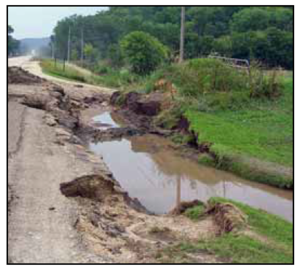
Construction stormwater best management practice – Preventing further damage after floods
Contents
Preventing further damage after floods
Under normal conditions, builders, developers and landowners, like you, apply for a construction stormwater permit for sites over an acre, and for sites under an acre that are part of a larger common plan of development.
Coverage under this general permit authorizes you to discharge stormwater from your construction site if permit conditions are met.
A "stormwater pollution prevention plan" or SWPPP is part of the application process. The SWPPP outlines how you intend to use best management practices, like stormwater detention ponds, silt fences, storm-drain inlet covers and temporary vegetative cover on project slopes, to manage stormwater runoff.
The application process for obtaining permit coverage is not simply a paperwork exercise. A carefully implemented stormwater pollution prevention plan prevents erosion and controls sediment from leaving your construction site.
Special circumstances
The environmental devastation of the flooding in southeastern Minnesota, in 2007, highlights the need for controlling stormwater. Scoured hillsides and washedout roads are dramatic examples of the power of water to transform the landscape. Preparation and implementation of a SWPPP ensures that you're not compounding the environmental harm caused by the floods.
A provision in the state's stormwater rules (Minn. R. 7090.2020) allows certain emergency construction activities to begin before a permit application is submitted, so long as the construction activity is needed to minimize the impacts of the emergency situation that present an "imminent threat to human health, public drinking water or the environment." In such cases, the landowner needs to notify the Minnesota Pollution Control Agency (MPCA) immediately when construction begins, followed by the application soon after.
The rule allows flexibility in meeting construction stormwater permit application requirements in emergency situations, and should not be interpreted as an exemption from permit requirements in the flooded areas. This provision is applied only in rare cases where there is an "imminent threat" to humans, drinking water or the environment.
Regulatory context
Compliance with Minnesota's construction stormwater permit ensures that builders meet federal requirements for water protection found in the Clean Water Act.
Minnesota is one of several states with delegated authority from the U.S. EPA to enforce federal Clean Water Act requirements.
How to apply
To apply for construction stormwater permit coverage, go to the MPCA Construction Stormwater Page to find all the permit application and guidance documents.
When you've completed your stormwater pollution prevention plan, apply directly online: Go to https://rsp.pca.state.mn.us and click on "Construction Stormwater Permit."
Sediment and erosion control
These five steps will help you get your job done without damaging the environment:
1. Stabilize slopes:'
Without vegetation, whole hillsides are quickly washed away in a downpour. Cover your slopes with mats or mulch that will get plants growing right away.
2. Control your perimeter:
Watch the flow of water on and off your site. Silt fences and other barriers make sure dirt doesn't escape. Embankments may keep extra water from entering your site.
3. Maintain silt fences:
Silt fences only work so long, so replace them if they're torn or beat down. They'll also need to be replaced if silt has reached one-third the height of the fence.
4. Stop vehicle tracking:
Install vehicle entrance and exit best management practices (BMPs), such as course gravel, to keep mud and sediment from leaving your sites onto roads and residential streets. If vehicle entrance/exit BMPs are inadequate, use additional street sweeping to prevent sediment from leaving the project site.
5. Protect inlets:
Prevent your stormwater ponds from filling with silt when you install storm-sewer inlet protection.
Contact the MPCA
If you have questions about the administrative details of the permit process go to the MPCA Stormwater page or call the Stormwater Hotline at 651-757-2119 or toll-free at 800-657-3804.
This page was last edited on 23 November 2022, at 18:21.
